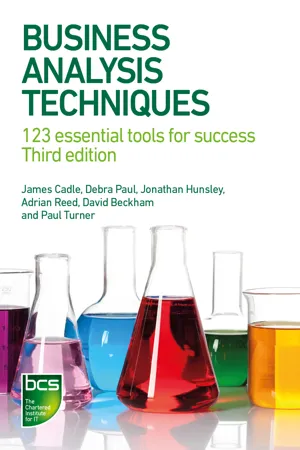
Business Analysis Techniques
123 essential tools for success
- 388 pages
- English
- ePUB (mobile friendly)
- Available on iOS & Android
Business Analysis Techniques
123 essential tools for success
About this book
Business Analysis has never been more important, and valuable, to organisations as they strive to adapt to an ever-changing and faster-changing environment. This expanded edition of Business Analysis Techniques provides detailed guidance on the range and application of the techniques available to assist business analysts and others in their work.
Business Analysis Techniques provides a foundation for the effective specification, design and development of digital solutions, solutions that are based on a proper understanding of the real business need and the requirements for solutions to meet them. With 123 of the most widely used techniques covered, this book is an essential resource for any business analyst.
This book:
- Places a large number of techniques into the context of the Business Analysis Service Framework, providing clear guidance on the applicability and use of 123 of the most-used techniques available in the business analyst's toolbox
- Provides detailed information on the use of each technique
- Accessibly written with worked examples of all of the techniques described
- Offers practical tips for using and adapting the techniques in the real world
Pair it with Business Analysis, also published BCS for even greater insights.
Frequently asked questions
- Essential is ideal for learners and professionals who enjoy exploring a wide range of subjects. Access the Essential Library with 800,000+ trusted titles and best-sellers across business, personal growth, and the humanities. Includes unlimited reading time and Standard Read Aloud voice.
- Complete: Perfect for advanced learners and researchers needing full, unrestricted access. Unlock 1.4M+ books across hundreds of subjects, including academic and specialized titles. The Complete Plan also includes advanced features like Premium Read Aloud and Research Assistant.
Please note we cannot support devices running on iOS 13 and Android 7 or earlier. Learn more about using the app.
Information
1 STRATEGIC CONTEXT
- Identifying the tactical options that will address a given situation and will support the delivery of the business strategy.
- Defining the tactics that will enable the organisation to achieve its strategy.
- Supporting the implementation and operation of those tactics.
- Redefining the tactics after implementation to take account of business changes and to ensure continuing alignment with business objectives.
- Maintaining an awareness of the external business environment.
- Working with other stakeholders such as product managers and product owners to develop the medium- and long-term strategy for a product or service and aligning this with the broader organisational strategy.
- strategy analysis, including external environment and internal capability;
- strategy definition;
- strategy implementation;
- performance measurement.
- PESTLE analysis;
- Porter’s five forces analysis.
- Ansoff’s matrix;
- growth share matrix;
- resource audit;
- VMOST analysis.
- business model canvas;
- cultural web;
- business capability model;
- information concepts model;
- SWOT analysis.
- balanced scorecard;
- critical success factors;
- key performance indicators.
Category | Description |
Political | Examples of political factors could be a potential change of government, with the corresponding changes to policies and priorities, or the introduction of a new government initiative. These may be limited to the home country within which the organisation operates, but this tends to be rare these days since many changes have an effect in several countries. The development of bodies such as the European Union (EU) and the growth of global trade and multinational organisations have changed the scope of political activity. This has increased the possibility of political issues arising that may impact upon the organisation and how it operates. |
Economic | Economic factors may also be limited to the home country, but as global trade continues to grow, economic difficulties in one nation tend to have a broad, often worldwide, impact. Examples of economic factors could be the level of growth within an economy, or market confidence in the economies within which the organisation operates. The economic impact of the United Kingdom (UK) leaving the EU, and its impact on domestic UK businesses, is a recent example. |
Socio-cultural | Socio-cultural factors are those arising from customers or potential customers. These changes ca... |
Table of contents
- Front Cover
- Half-Title Page
- BCS, The Chartered Institute for It
- Title Page
- Copyright Page
- Contents
- Figures and tables
- Authors
- Foreword
- Acknowledgements
- Abbreviations
- Useful websites
- Preface
- 1. Strategic Context
- 2. Situation Investigation
- 3. Feasibility Assessment and Business Case Development
- 4. Business Process Improvement
- 5. Requirements Definition
- 6. Business Acceptance Testing
- 7. Business Change Deployment
- 8. Stakeholder Engagement
- Bibliography
- Index
- Back Cover